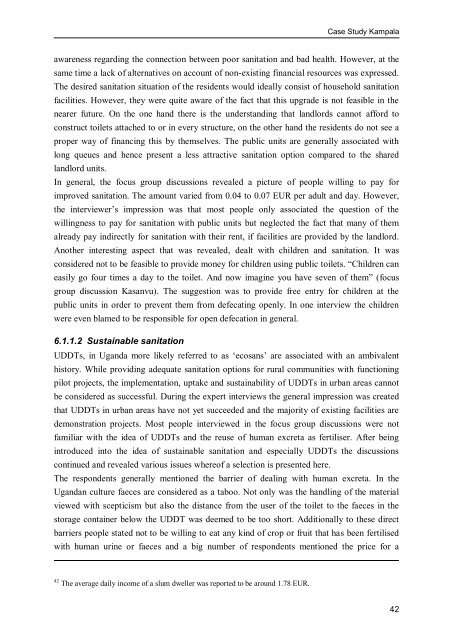Economic Effects of Sustainable Sanitation - SuSanA
Economic Effects of Sustainable Sanitation - SuSanA
Economic Effects of Sustainable Sanitation - SuSanA
You also want an ePaper? Increase the reach of your titles
YUMPU automatically turns print PDFs into web optimized ePapers that Google loves.
Case Study Kampala<br />
awareness regarding the connection between poor sanitation and bad health. However, at the<br />
same time a lack <strong>of</strong> alternatives on account <strong>of</strong> non-existing financial resources was expressed.<br />
The desired sanitation situation <strong>of</strong> the residents would ideally consist <strong>of</strong> household sanitation<br />
facilities. However, they were quite aware <strong>of</strong> the fact that this upgrade is not feasible in the<br />
nearer future. On the one hand there is the understanding that landlords cannot afford to<br />
construct toilets attached to or in every structure, on the other hand the residents do not see a<br />
proper way <strong>of</strong> financing this by themselves. The public units are generally associated with<br />
long queues and hence present a less attractive sanitation option compared to the shared<br />
landlord units.<br />
In general, the focus group discussions revealed a picture <strong>of</strong> people willing to pay for<br />
improved sanitation. The amount varied from 0.04 to 0.07 EUR per adult and day. However,<br />
the interviewer‘s impression was that most people only associated the question <strong>of</strong> the<br />
willingness to pay for sanitation with public units but neglected the fact that many <strong>of</strong> them<br />
already pay indirectly for sanitation with their rent, if facilities are provided by the landlord.<br />
Another interesting aspect that was revealed, dealt with children and sanitation. It was<br />
considered not to be feasible to provide money for children using public toilets. ―Children can<br />
easily go four times a day to the toilet. And now imagine you have seven <strong>of</strong> them‖ (focus<br />
group discussion Kasanvu). The suggestion was to provide free entry for children at the<br />
public units in order to prevent them from defecating openly. In one interview the children<br />
were even blamed to be responsible for open defecation in general.<br />
6.1.1.2 <strong>Sustainable</strong> sanitation<br />
UDDTs, in Uganda more likely referred to as ‗ecosans‘ are associated with an ambivalent<br />
history. While providing adequate sanitation options for rural communities with functioning<br />
pilot projects, the implementation, uptake and sustainability <strong>of</strong> UDDTs in urban areas cannot<br />
be considered as successful. During the expert interviews the general impression was created<br />
that UDDTs in urban areas have not yet succeeded and the majority <strong>of</strong> existing facilities are<br />
demonstration projects. Most people interviewed in the focus group discussions were not<br />
familiar with the idea <strong>of</strong> UDDTs and the reuse <strong>of</strong> human excreta as fertiliser. After being<br />
introduced into the idea <strong>of</strong> sustainable sanitation and especially UDDTs the discussions<br />
continued and revealed various issues where<strong>of</strong> a selection is presented here.<br />
The respondents generally mentioned the barrier <strong>of</strong> dealing with human excreta. In the<br />
Ugandan culture faeces are considered as a taboo. Not only was the handling <strong>of</strong> the material<br />
viewed with scepticism but also the distance from the user <strong>of</strong> the toilet to the faeces in the<br />
storage container below the UDDT was deemed to be too short. Additionally to these direct<br />
barriers people stated not to be willing to eat any kind <strong>of</strong> crop or fruit that has been fertilised<br />
with human urine or faeces and a big number <strong>of</strong> respondents mentioned the price for a<br />
42 The average daily income <strong>of</strong> a slum dweller was reported to be around 1.78 EUR.<br />
42

















